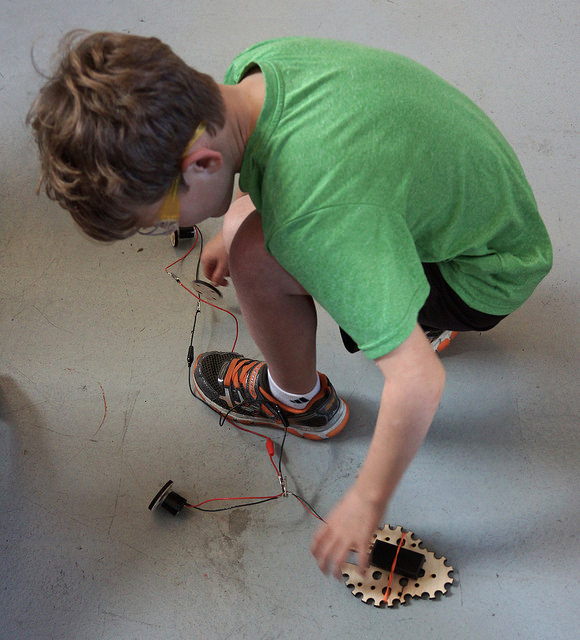
Challenges, Not Instructions: Three Tips for Naturally Personalized Learning

One of the more whimsical Electric Motors Catalyst challenges.
“Look out – it works!”
Two of the teachers in our workshop at the Education Elements Personalized Learning Summit had just gotten their wheel-launcher to work, and they were bubbling with excitement. When I saw the little wooden wheel fly across the room, I went over to check it out (trying to keep out of the line of fire). Their invention, made from a small electric motor, some laser-cut wooden parts, and rubber bands, was certainly an effective wheel flinging machine!

It was also completely different from any other wheel launcher I had ever seen. This was not a surprise. We created the Electric Motors Catalyst kit with the goal of making it easy for educators and parents to bring open-ended, challenge-based learning to children. To ensure that every student can apply their unique abilities and creativity to the challenge, there must be a wide variety of ways to succeed. It’s one of our core concepts: “Create a Wide Solution Space.” And every time we run a Tinkering session, whether it’s with first graders, middle schoolers, or grown up teachers, we see brand new ways of meeting the 10 Challenges that come with our kit.
Open-ended learning, when grounded in a few key principles, is naturally personalized because it is inherently designed to allow every student to approach it in her own way. Here are the three principles that we find most important:
- Challenges, Not Instructions
- Create a Wide Solution Space
- High Speed / Low Precision
“Challenges, Not Instructions” is #1. Tell students what you want them to achieve, not what you want them to do. This gives students an opportunity to practice their independent problem solving skills in addition to allowing for a personalized experience.

The Electric Motors Catalyst comes with 10 Challenge Cards.
“Create a Wide Solution Space” is next. This is important not only to allow each individual to approach the project in her own way, but also to increase the chance of a successful outcome. Not to say that failure is completely undesirable; dead-ends, ineffective designs, and ideas that just plain don’t work are all essential in any creative process. But the best open-ended learning experiences allow students to eventually find their way to a successful outcome, and one of the best ways to increase the chances of that is by ensuring that there are many ways to succeed.
For an example of a wide solution space, check out these two answers to the challenge “Build a machine that can cut a piece of paper.” First we have a device made by 1st graders:
Next, one created by a high school senior and his older brother:
That brings us to “High Speed, Low Precision.” What we mean by “High Speed” is that it should be easy for students to rapidly try many different ideas and approaches. “Low Precision” means that the project should not require the delicate touch of a watchmaker. In the Electric Motors Catalyst kit, we use rubber bands for attaching parts together for this very reason. Rubber bands are fast to apply, fast to remove, and let you make small adjustments of placement with a nudge. This makes it easy for students to try something as quickly as they think of it, and quickly move on to the next idea if it does not work.
I hope you’ll find these ideas useful for bringing naturally personalized learning to your students. Let me know how it goes! You can find us on twitter @tinkeringlabs or email us at tinkering@tinkeringlabs.com.

